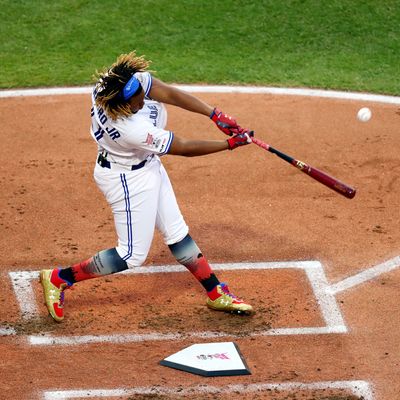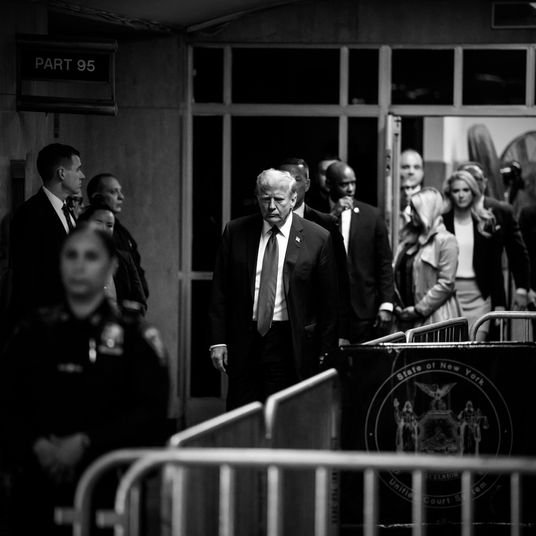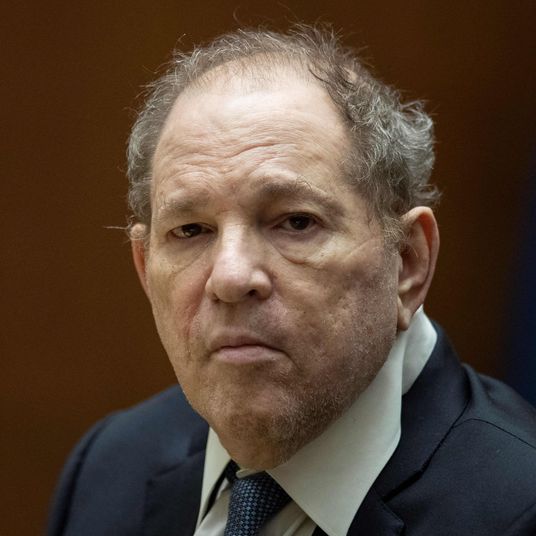
When was the last time baseball transcended its fan base and broke into the broader culture? For my money, it has happened only once since the season began back in March: at last week’s Home Run Derby. On Monday night, the day before the annual MLB All-Star Game, Vladimir Guerrero Jr., the son of one of the most purely enjoyable baseball players of the last 20 years, went full-on maniac on batting-practice fastballs, hitting an absurd 29 home runs in four minutes and 30 seconds, one home run every nine seconds. It’s something that’s never even come close to being accomplished before, and Vlad Jr. did it with considerable panache, his hair flapping like it was holding on for dear life. It was an incredible physical achievement from an incredible physical athlete. It was why we watch sports.
The Home Run Derby, after years of Chris Berman–induced fatigue, has had a resurgence of popularity in recent years, thanks largely to a rule change a few years ago that turned the event into a timed sprint rather than an endless dirge. And it is now arguably just as popular, if not more so, than the All-Star Game itself, which had record-low ratings this year. Those ratings were still higher than the Derby ratings, but only barely, and certainly only because the Derby was on cable while the All-Star Game remains on Fox broadcast television. Television ratings for sports, especially baseball, should always be taken with a bit of sodium; ratings are a snapshot to gauge how many people tuned in, but they are an unreliable measure of how popular or significant an event was. This is particularly true for an event with the regional relevance and ubiquity of baseball. But you can’t help but notice: Casual fans increasingly seem more interested in baseball when it has less, you know, baseball in it. Fans love homers. Fans love to watch baseballs be hit a long way. As the old, now-sorta-cringey Nike commercial went, chicks dig the long ball.
This is, suffice it to say, not the current conversation among baseball enthusiasts. Baseball is going through one of its seemingly regular identity crises. Past crises include “steroids,” “gambling scandals,” and “apocalyptic labor disputes” (look for the return of last one coming your way in the next couple of years), but the crisis du jour is a strange one: Players are hitting too many home runs. Major League Baseball set a record for the number of home runs in 2017 with 6,105, but that number is on pace to be shattered in 2019, with 6,591 expected. April featured the most home runs ever in that month, and May featured the most home runs ever in any month, and June had an even higher homer rate than that. Half the teams in baseball will hit more home runs than any time in their history this year. All-Star Game starting pitcher Justin Verlander, one of the game’s most beloved, outspoken figures, said that during the game’s signature week that MLB was “turning the game into a joke.” The game has turned into the Moneyball-esque Three True Outcomes efficiency nightmare: Players are homering, they’re walking, or they’re striking out. Here’s a wild stat: There are now more strikeouts in baseball than there are hits. That happened last year for the first time in baseball history, and it’s happening this year too.
There are many theories as to why this is occurring. The “launch angle” revolution — selling out for home runs and not sweating small-ball techniques of bunting and stealing bases — has players swinging freely and for the fences; home runs look a lot better for a player going into salary arbitration than moving runners over into scoring position. Increased pitch velocity is making hitting so difficult that your only real option is swinging as hard as you can and just hoping you make contact. But the simplest answer is probably what makes the most sense: The balls are juiced. FiveThirtyEight’s Rob Arthur has been on the juiced-ball beat for years now, and the evidence is overwhelming that balls are simply traveling farther than they ever have before. (This off-season, Triple-A teams started using MLB balls … and home runs are up 50 percent.) MLB commissioner Rob Manfred insists there’s nothing nefarious, that he hasn’t told anyone to pump up the balls, and said he will be looking into the issue, which observers believe results mostly from tighter seams. Whether or not you believe Manfred that the league had nothing to do with it, something is obviously up.
But is this really a problem for baseball? Are too many dunks bad for basketball? Sure, it might be a problem for Generation-X fans who grew up watching the Whitey Herzog Royals and Cardinals teams of the ’80s that got by with speed and AstroTurf defense. But baseball is constantly changing, and older fans who grew up with the game being played a certain way are constantly complaining about it: Grousing about how the game isn’t the way it used to be is as much a baseball tradition as spitting and adjusting your cup. But if baseball is going to evolve into something new and different, during a time when young fans have been turning away from the game, one has to admit there are worse ways for it to evolve than into an all-time increase in the most exciting play in the whole sport. If baseball had a sudden increase in weak ground balls to the second-baseman or pitchers falling asleep on the mound, I’d be more concerned.
Whether or not juicing the ball is intentional, it’s difficult to agree with the “traditionalists” that this sort of home-run happiness is “bad for baseball.” People love homers! There is a cathartic thrill in watching someone like Vlad Jr. or the Mets’ Pete Alonso, huge men launching baseballs deep into the endless night. You’re going to tell me this isn’t more fun, more viscerally appealing, than a well-placed sacrifice fly? Really?
Baseball is not going to get back to its peak popularity of the mid-to-late-20th century. (Though even that can be overstated: Look how empty the stands were when Roger Maris hit his record-breaking 61st home run.) The culture is too fragmented, attention spans are shorter, and there are simply too many entertainment options. All of the major American sports face the same challenge, of course, but it’s baseball that always seems to be entrapped by its past, by the perpetual lingering sensation that somehow things used to be better, even if they weren’t. I write a regular series for MLB.com about this soon-to-end decade of baseball, and I’ve realized that there are ways in which baseball has become entirely unrecognizable as compared to 2010 — and I’ll be saying the same thing in 2029 when I compare it to right now. Baseball will change again, into whatever direction trends and science and style pull it, and everyone who falls in love with it now will complain about all the changes, and on and on it will go. But if baseball has to change … an unprecedented number of shockingly mammoth dingers doesn’t seem like the worst way to go, no?






























